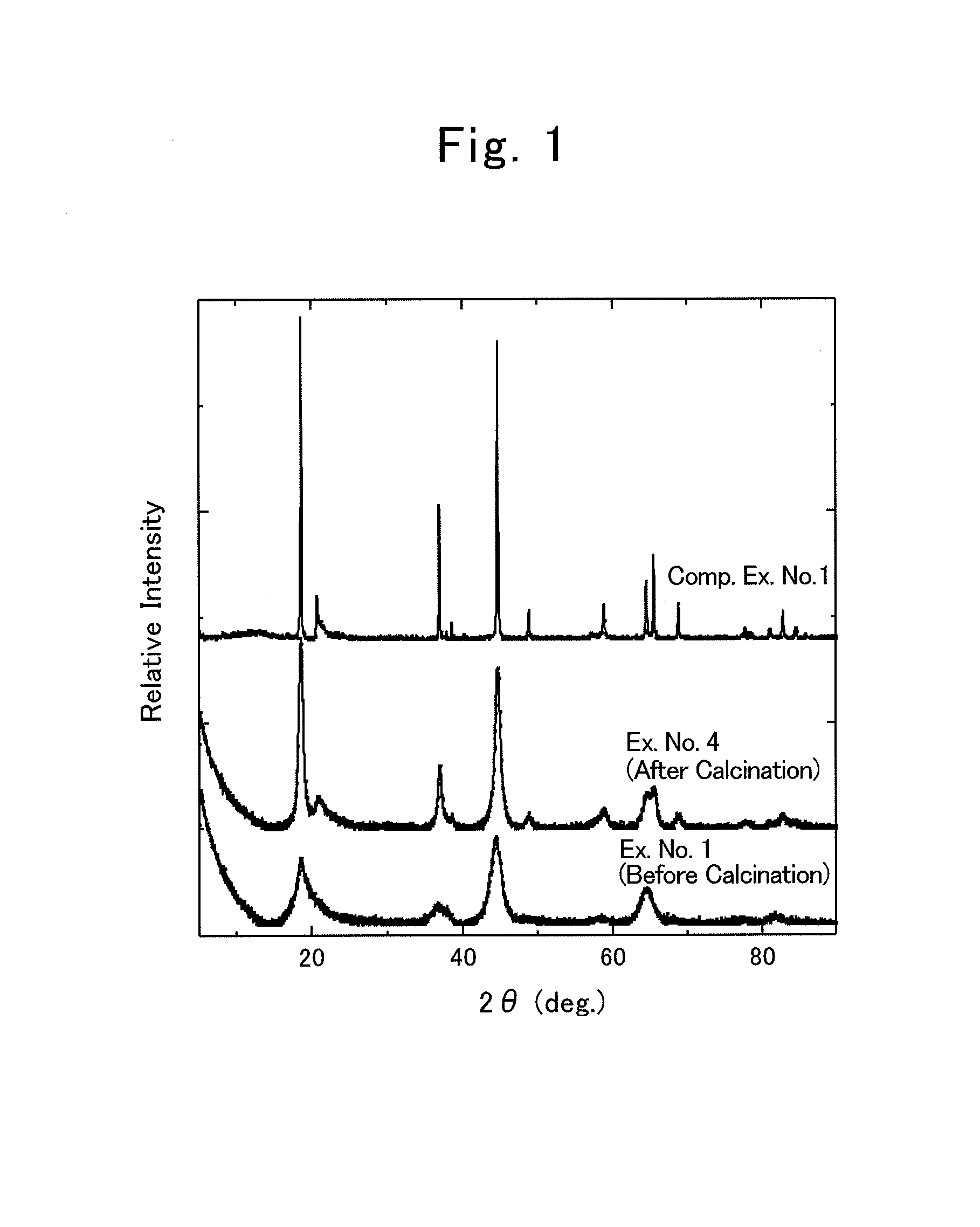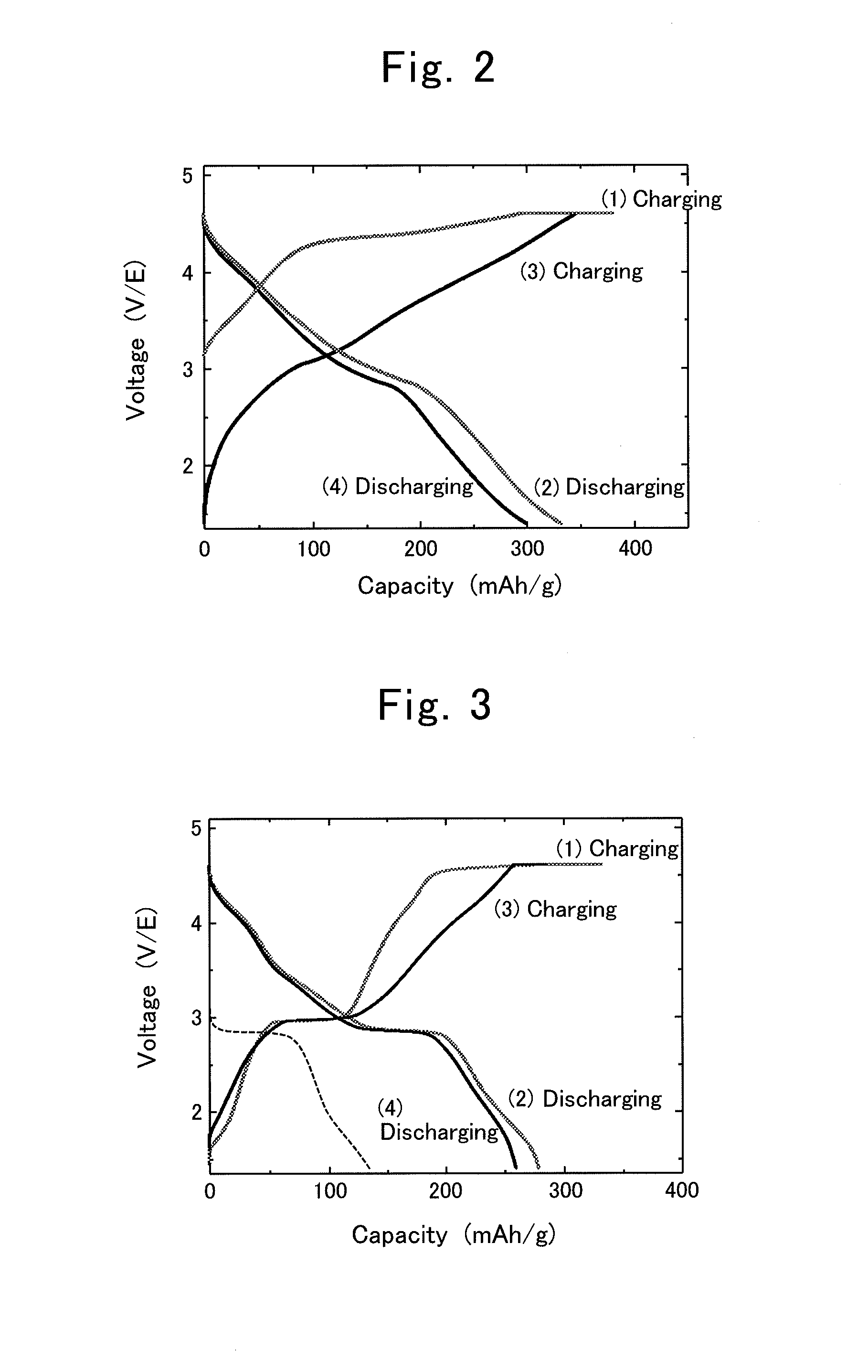Production process for composite oxide, positive-electrode active material for lithium-ion secondary battery and lithium-ion secondary battery
a production process and active material technology, applied in the manufacture of final products, cell components, manganates/permanentates, etc., can solve the problems of not being able to obtain nano-order fine particles, and not being able to make composite oxides including lisub>2
- Summary
- Abstract
- Description
- Claims
- Application Information
AI Technical Summary
Benefits of technology
Problems solved by technology
Method used
Image
Examples
examples
[0077]Hereinafter, the present invention will be explained in detail while giving specific examples of the production process for composite oxide, positive-electrode active material for lithium-ion secondary battery and lithium-ion secondary battery according to the present invention.
[0078]Based on the aforementioned embodiment modes, composite oxides comprising dual crystalline structures of layered rock-salt structure and spinel structure were synthesized by the following procedures.
example no.1
Example No. 1
Synthesis of Li2MnO3-Spinel Mixed-Phase Compound
[0079]0.10-mol (i.e., 4.2-gram) lithium hydroxide monohydrate, LiOH.H2O, was mixed with 0.15-mol (i.e., 10.3-gram) lithium nitrate, LiNO3, to prepare a molten-salt raw material. To this, 0.010-mol (i.e., 0.87-gram) manganese dioxide, MnO2, was added as a metallic-compound raw material, thereby preparing a raw-material mixture. That is, the ratio, namely, (Transition Metal in Metallic-compound Raw Material) / (Lithium Metal in Molten-salt Raw Material), was 0.01 mol / 0.25 mol=0.04.
[0080]The raw-material mixture was put in a crucible being made of mullite, and was then vacuum dried by a vacuum drier at 120° C. for 12 hours. Thereafter, the drier was returned back to the atmospheric pressure; the crucible, in which the raw-material mixture was held, was taken out and was then transferred immediately to an electric furnace, which had been heated to 350° C., and was further heated at 400° C. for 1 hour in air. On this occasion, th...
example no.2
Example No. 2
Synthesis of Al-substituted Li2MnO3-Spinel Mixed-Phase Compound
[0086]0.10-mol (i.e., 4.2-gram) lithium hydroxide monohydrate, LiOH.H2O, was mixed with 0.20-mol (i.e., 13.8-gram) lithium nitrate, LiNO3, to prepare a molten-salt raw material. To this, a precursor was added as a metallic-compound raw material in an amount of 1.0 g to prepare a raw-material mixture. Hereinafter, a synthesis procedure for the precursor will be explained.
[0087]0.95-mol (i.e., 272.7-gram) Mn(NO2)2.6H2O, and 0.05-mol (i.e., 18.8-gram) Al(NO3)3.9H2O were dissolved in 500-mL distilled water to make a metallic-salt-containing aqueous solution. While this aqueous solution was stirred within an ice bath using a stirrer, one in which 50-gram (i.e., 1.2-mol) LiOH.H2O had been dissolved in 300-mL distilled water was dropped to the aqueous solution over a time period of 2 hours to alkalify it, thereby precipitating deposits of metallic hydroxides. While keeping this solution holding the deposit therein ...
PUM
 Login to View More
Login to View More Abstract
Description
Claims
Application Information
 Login to View More
Login to View More - R&D
- Intellectual Property
- Life Sciences
- Materials
- Tech Scout
- Unparalleled Data Quality
- Higher Quality Content
- 60% Fewer Hallucinations
Browse by: Latest US Patents, China's latest patents, Technical Efficacy Thesaurus, Application Domain, Technology Topic, Popular Technical Reports.
© 2025 PatSnap. All rights reserved.Legal|Privacy policy|Modern Slavery Act Transparency Statement|Sitemap|About US| Contact US: help@patsnap.com


